|

 Up
Up 
 Wright Trivia
Wright Trivia

(You are here.)



  Need
to Need
to
find your
bearings?
Try
these
navigation aids:
If
this is your first
visit, please stop by:
Something
to share?
Please:



|
|
Available in Française, Español, Português, Deutsch, Россию,
中文,
日本, and others.
 ere
are a few little known (but fascinating) facts about the Wright brothers: ere
are a few little known (but fascinating) facts about the Wright brothers:
|
|
Awards
and Honors
The Wright brothers received major awards and honors of all
descriptions on many occasions. Some were awarded to Wilbur posthumously
after he died in 1912:
- Congressional Medal of Honor, awarded June 17,
1909.
After the Wrights had returned home from a triumphant tour of Europe, they
were awarded this medal during the Wright Brothers' Home Days
Celebration on June 17 and 18, 1909. They also received gold medals
from the State of Ohio and the City of Dayton.
- Coupe Michelin d'Aviation, awarded
January, 1909.
On December 31, 1908, Wilbur Wright set a world's record flying for
2 hours and 18 minutes, traveling 77 miles (123 kilometers) at
Avours, France. For this the Aero Club of France awarded him the
Michelin Cup and 20,000 francs.
- Langley Medal, awarded February 10, 1910.
Wilbur and Orville Wright received the newly created "Langley Medal"
for their aeronautical achievements from President Howard Taft at
the White House in Washington, DC.
- Legion of Honor, awarded June 20, 1909.
Created by
Napoleon Bonaparte, the French Legion of Honor is an order of merit
given to individuals without regard to birth or religion, provided
they swear to uphold the values of liberty and equality. Orville,
Wilbur, and Katharine Wright were so honored after their successful
aviation demonstrations in 1908 and 1909.
- Collier Trophy, awarded February 3, 1914.
Established in 1911 by Robert Collier, the Collier Trophy was presented
annually for the most significant contribution to aeronautics. Glenn
Curtiss won the trophy for the years 1911 and 1912, and Orville Wright won
it for 1913 for the Wrights' automatic stabilization system, the
forerunner of the automatic pilot.
- Albert Medal of the Royal Society of the Arts (in Great
Britain), awarded October 27, 1917.
Established in 1864, the Albert Medal acknowledges the creativity
and innovation of those who work to solve the world's most
intractable problems. Presented to Orville Wright and Wilbur Wright
(posthumously) for being "the first persons to ascend from earth in
a mechanically propelled aeroplane."
- Distinguished Flying Cross, awarded July 2, 1926.
Conferred by the President of the United States and authorized by an
act of Congress to Orville Wright and (posthumously) Wilbur Wright
for "heroism and extraordinary achievement, {who by their] vision,
perseverance, courage, and skill, designed, constructed, and
operated the airplane at Kitty Hawk, North Carolina, on 17 December
1903, made the first successful flight under its own power and
carrying a human operator thereby making possible achievements which
are now stirring the emotions and pride of this world."
- Washington Award, awarded June 1,1927.
From the Western Society of Engineers (now the Society of American
Engineers, for professional engineers whose "attainments have
preeminently advanced the welfare of human kind."
- Distinguished Service Medal, awarded March 29, 1932
From the Civitan Club, now Civitan International, an organization of
volunteer service clubs around the world.
- Daniel Guggenheim Medal, awarded April 8, 1930.
Orville Wright and his (deceased) brother Wilbur were the first
recipients of this award, established to recognize major
contributions to the science of aeronautics.
- Aviation Hall of Fame, enshrined December, 1962.
Wilbur and Orville Wright were among the first twelve aviators
enshrined in the National Aviation Hall of Fame at its first
enshrinement ceremony in Dayton, Ohio, December, 1962.
|
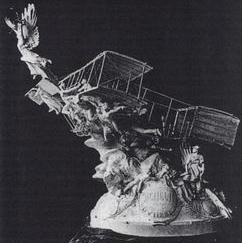
The original design for the 1908 Michelin Cup. After Wilbur won it,
the Farman airplane was replaced with a Wright Flyer.
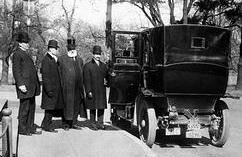
The Wright brothers on their way to the White House to receive the
Langley Medal. The bearded gentleman in the top hat is Alexander
Graham Bell.
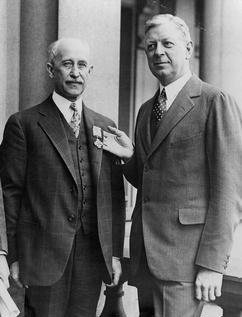
Orville Wright with Secretary of War Dwight Davis on the steps of
the White House after receiving the Distinguished Flying Cross.
|
Boats
Wilbur and Orville Wright owned several boats that we know of.
In late September of 1909, the Wright brothers were contracted to
make exhibition flights at the Hudson-Fulton Celebration in New York
City. They would use Governor's Island (just south of Manhattan) as an
airfield, flying out over Upper Bay and the Hudson River. Wilbur, who
would be the pilot, was worried that their aircraft would sink if it
were forced down into the water. As a safety measure, he went into New
York City and bought a bright red J.H. Rushton "Indian Girl"
canoe from the Folsom Arms Company, an outfitters store. He took this
back to Governors Island where he and Charlie Taylor stretched a canvas
cover across the top, waxed the cloth to make it watertight, then
attached the canoe to the bottom of the Flyer. If the airplane was
forced to make a water landing, the canoe would act as a pontoon and
keep the craft afloat. Wilbur made two exhibition flights: On September
29, how flew around the Statue of Liberty. On October 4, he flew to
Grant's Tomb (in Harlem) and back. Afterwards, the canoe was shipped
back to Dayton, Ohio where Orville kept it at the Dayton Canoe Club on
the Great Miami River so it could be enjoyed by his nieces and nephews.
At some point, it was painted green. Today it is on display at
Carillon Park.
When Orville first visited Georgian Bay in Lake Huron in 1916, he
learned to sail in an Aykroyd sailing dinghy (also called a "catboat").
Later, after he had purchased Lambert Island in the
Georgian Bay, Orville bought one of these dinghies, kept it at his
boathouse, and sailed it during his yearly visits to the island.
Visitors reported that in addition to the catboat, he also had a rowboat
and a canoe.
Orville needed a more practical form of water transportation to travel
large distances, such as the distance between the mainland and
his island home. The Gidley Boat Co. of Penetanguishene, Ontario
supplied him with several boats, the last of which – the "Kittyhawk"
– still exists. It was built in 1930 as a water taxi, then returned to
Gidley when the first owner could not make the payments. Orville bought
it in 1931 and had a sedan top installed to protect his passengers from
foul weather. It had a sleek mahogany hull, 32.5 feet (10 meters) long and 8 feet
(2.4 meters) at
the beam. Orville was never satisfied with the original Ford Model T
engine and in 1941 – his last year at Lambert Island – he had Grew
Manufacturing (which had bought Gidley) install a powerful eight-cylinder Kermath
marine engine. Orville
did not name the boat, but his neighbors on Georgian Bay presented him
with a set of stainless steel capital letters that read "KITTY
HAWK" one
Christmas. Orville had the boat company install the letters but unfortunately the
workers did not realize that Kitty Hawk, where Orville and Wilbur had flown, was two words.
The spelling mistake
persists to this day.
Orville last used the Kittyhawk in 1941, and it was used for
several years after his death in 1948 by Orville's nieces and nephews
who had inherited the Lambert Island vacation home. It was purchased from
the Wright estate in 1952 and used as a taxi and to ferry construction materials until
the hull was damaged. It lay in a sling in its dock until
1972, when it was sold to and meticulously restored by Guy and Kathy Johnstone. It
cruised Georgian Bay for many years and was kept in immaculate shape
with additional restoration work in 1988 and 2006. The Johnstones are
currently looking for someone to take over the stewardship of this
unique piece of aviation and marine history – for more information.
about the sale of the Kittyhawk, click
HERE.
|

Wilbur flies past the New York City skyline with an
Indian Girl canoe lashed
beneath his Wright Model A Flyer.
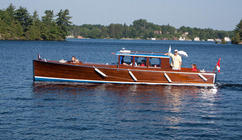
The restored Kittyhawk, Orville's 1931 runabout he used to get back
and forth from Lambert Island in Georgian Bay of Lake Huron. For
more information on the boat and Orville's time in Canada, click
HERE.
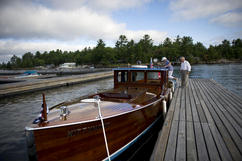
The Kittyhawk tied up at a dock. Note the stainless steel lettering
on the bow.
Note: Guy and Kathy
Johnstone, who have cared for the Kittyhawk
since 1972, are currently looking to sell the boat. (For more
information about the sale, click
HERE.) We sincerely hope the
Johnstones will find someone who can appreciate, preserve, and
promote its unique history as well as they have.
|
Boy
Scouts
Orville Wright actively promoted scouting and sat on the Dan
Beard Council of the Boy Scouts of America. He was himself an "honorary
scout" and the scouting advisor
for the Aviation Merit Badge. (Who better?). The Boy Scouts had an
aviation program almost since their inception -- they first offered an
"Airman's Badge" in 1911. With the onset of World War II, interest in
aviation grew so intense that the Boy Scouts organized the Air Scouts as
a subdivision in 1941. Orville participated in the Air Scouts as both an
advisor and promoter. In 1949 (shortly after Orville's death) the Air
Scouts became the Air Explorers and continued until 1965 when the
program was folded into the Boy Scouts of America Explorers.
|
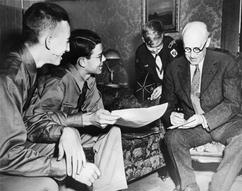
Orville Wright with two Air Scouts and a Cub Scout in 1943.
|
Crashes
Orville Wright survived eight major crashes:
- While flying a glider at Kitty Hawk, NC on 23 September 1902.
- While flying the 1904 Wright Flyer II at Huffman Prairie near
Dayton, OH on 24 August 1904.
- While flying the 1904 Wright Flyer II at Huffman Prairie on 1
November 1904.
- While flying the 1905 Wright Flyer III at Huffman Prairie on 14
July 1905.
- While flying a Wright Model A at Fort Myer, VA on 17 September
1908. This was by far his worst accident; breaking his leg and
killing his passenger, Lt. Thomas Selfridge.
- While flying the Wright Military Flyer at Fort Myer, VA a year
later on 2 July 1909.
- While flying the 1911 Wright Glider at Kitty Hawk, NC on 18
October 1911. It was during this trip that Orville set the first
soaring record, staying aloft for nearly 10 minutes.
- While flying the 1911 Wright Glider at Kitty Hawk, NC on 23
October 1911. Both crashes occur when the glider is upset while
flying in a high wind.
Orville also survived a nasty train wreck while in France. On 16
January1909 he and Katharine were on their way to join Wilbur in Pau
when their express passenger train collided with a slower local train 30
miles (48 kilometers) from their destination. Orville and Katharine were
unhurt, but two people died in the crash.
Wilbur also experienced many crashes, most of them minor. His most
serious crash was on 14 May 1908 when he lost control of the 1905 Wright
Flyer III (reconfigured as a Wright Model A) while testing a new engine,
a new control system, and upright seating at Kitty Hawk, NC. The
airplane was damaged beyond repair and never flew again, but Wilbur was
unhurt. He also crashed in public on August 13, 1908, at the Hunaudiéres
Race Course near Le Mans, France, breaking the left wing of his Wright
Model A. Again, he was unhurt.
|

The Wright brothers worst accident occurred at Fort Myer, VA when a
propeller broke and snagged the wires that held the rudder in place.
The Flyer became uncontrollable and dove for the ground.
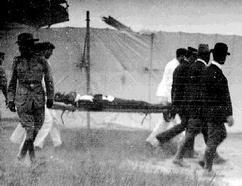
Orville Wright is carried from the wreck at Fort Myer.
|
Education
Neither Wilbur or Orville Wright received a high school diploma. Wilbur
completed his senior year at Richmond High School in Indiana with good
grades (about a 95 average), but did not apply for a diploma. The Wright
family moved to Dayton, Ohio before commencement and Wilbur never went
back to claim his certificate. Orville started a printing business when he
was 15 years old and was running a weekly newspaper by his junior year of
high school. His grades were mediocre (except for the sciences) and he had
obviously lost interest in school, so he did not go back for his senior
year.
Despite the lack of a high school certificate, both Wilbur and Orville
earned honorary graduate and post-graduate college degrees.
Honorary degrees awarded to Wilbur and Orville Wright
while Wilbur was still living:
- University of Munich, Munich, Germany —
Honorary Doctor of Engineering, March 5, 1909.
- Earlham College, Richmond, Indiana —
Honorary Bachelor of Science, June 16, 1909.
- Oberlin College, Oberlin, Ohio — Honorary
Doctor of Laws, June 22, 1910.
After Wilbur died in 1912, Orville was awarded these degrees:
- Polytechnicum of Chicago — Honorary Doctor
of Philosophy, March 31, 1915.
- Trinity College, Hartford, Connecticut —
Honorary Doctor of Science, June 23, 1915.
- Earlham College, Richmond, Indiana —
Honorary Masters of Science, June 14, 1917.
- University of Cincinnati — Honorary Doctor
of Science, June 16, 1917.
- Yale University— Honorary Master
of Arts, June 18, 1919.
- University of Michigan — Honorary
Doctor of Engineering, June 16, 1924.
- Ohio State University— Honorary Doctor of
Science, June 10,1930.
- Harvard University — Honorary Doctor of
Laws, June 19, 1930.
- Earlham College, Richmond, Indiana —
Honorary Doctor of Laws, June 15, 1931
- Huntington College, Huntington, Indiana —
Honorary Doctor of Laws, June 10, 1935
- University of Dayton, Dayton, Ohio —
Honorary Doctor of Science, December 19, 1943.
- Otterbein College, Westerville, Ohio — Honorary Doctor of
Science, June 9, 1947
All totaled, there were 15 honorary degrees awarded to one or
both of the brothers.
|

Orville's report card from 1888, the last full year that he attended
school.

Orville receives and honorary doctorate degree in Engineering for
the University of Dayton in 1943.
|
Huffman Prairie
Huffman Prairie, where the Wrights developed their experimental
powered aircraft into a practical flying machine, was first surveyed in
1802 and recorded as a "sedge meadow." Poor drainage and wet, alkali
soil had kept trees from growing, resulting in a prairie. This prairie first came to the
attention of the world in the 1830's when botanist John Leonard Riddell
discovered three new species of plants on the marshy land.
By an amazing coincidence, Riddell was also one of the earliest science fiction writers and wrote
about "aerial navigation."
When the Wrights asked to use a portion of the prairie as a flying field in 1904, the
area was still wet and (mostly) treeless. It was also covered with
hummocks, possibly formed by a type of sedge grass common in Ohio fens
and bogs. But the peat-like soil was also much softer than the
surrounding fields of unyielding clay. Furthermore, when the ground
froze in the winter the expanding ice created "frost heaves" in the
peat, making the surface soft and springy. Walking over it felt akin to walking on a
lumpy mattress. The Wrights may have chosen it partly for this reason – they hoped to soft ground would provide some
protection from hard landings and crashes. Whatever the reason, it was
unproductive as farmland, so the owner Torrence Huffman needed little
convincing to allow Orville and Wilbur to use it. Huffman Prairie also
offered easy access. The Dayton area had an extensive electric rail
system – the "Interurban" – and a spur ran between Dayton and the
village of Osborn. The stop right before the Interurban reached Osborn, called
Simms Station, was just across the road from Huffman Prairie. This was
another reason they chose this spot for their flying field. It was
relatively secluded, but they could easily commute to the Prairie from
west Dayton. The Wrights continued to use Huffman Prairie long after
they had developed a practical airplane. In 1910, they built a large
hangar directly across from the Interurban stop and began to train both
civilian and military pilots to fly. The Wrights set up temporary
schools in other parts of the country, but the Wright School of Aviation
at Simms Station was their main training facility until 1915. One
hundred and nineteen pioneer aviators learned to fly here.
As the United States enter World War I, Colonel Edward Deeds, a
Dayton industrialist and a member of the Munitions Standards Board,
mentioned to Major General George Squire of the US Signal Corp that
Huffman Prairie should be used to train pilots for the war. In May 1917,
the US Signal Corps leased Huffman Prairie and 2,245 acres surrounding
it for a US Signal Corps Aviation School. They named it Wilbur Wright
Field. Five months later, the Signal Corps also established a modest
experimental airplane testing facility near downtown Dayton called
McCook Field. In 1924 concerned Dayton businessmen, aware that the US
Army had outgrown McCook Field, purchased 4500 acres of land, including
Wilbur Wright Field and Huffman Prairie. They donated this to the US
government and in 1927 the expanded facility became Wright Field. The
testing facility at McCook Field, then known as the Air Corp Material
Division, was moved to Wright Field. In July 1931, a portion of Wright
Field was designated Patterson Field in honor of Lt. Frank Stuart
Patterson, son and nephew of the founders of National Cash Register
Company of Dayton, Ohio. Patterson had died while testing an airplane at
McCook Field. His father and uncle (Frank J. and John H. Patterson) had
been instrumental in buying the land that had become Wright Field and
keeping military aviation in Dayton; the renaming honored them as much
as it did Lt. Patterson. In September 1947, Congress created the United
States Air Force as a separate military service and in January 1948, the
same month that Orville Wright died, Wright Field and Patterson Field
were recombined into Wright-Patterson Air Force Base. In 1986, a
109-acre tract just east of the Wright brother's original flying field
was designated a State Natural Landmark by the Ohio Department of
Natural Resources, owing to the fact that it was an intact remnant of
Ohio's ancient prairies. This became the Huffman Prairie Conservation
Area .A few years later Wright-Patterson AFB began to restore this area,
hoping to create a botanical environment as close as possible to the
sedge meadow that John Riddell had once studied. Over the years, the
Ohio chapter of The Nature Conservancy and Five Rivers Metroparks (the
Dayton-area park system) also became involved. The conservation effort
waned briefly in 2002, but it was renewed again in 2008 when the Base
committed to eradicating invasive plant species in a 3-acre tract and
reseeding it with prairie flora. The results were not immediate –
botanists have found it can take 5 years or more for a reseeding program
to take effect – but the tract steadily improved. In 2012, the
Base began to reseed roughly half the Prairie Conservation Area and it
too is improving.
In 1990 the 84-acre tract that was the original flying field was
declared a National Historic Landmark. On 17 December 2002 – the 99th
anniversary of the Wrights' first powered flights – that land was
incorporated into the Dayton Aviation Heritage National Historic Park.
It remains part of Wright-Patterson Air Force Base, but it is open to
the public except in times of high military alert or inclement weather.
The flying field is accessible through Gate 16A off Route 444.
|
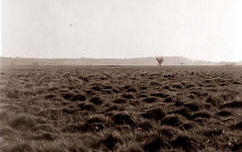
The hummocks at Huffman Prairie were probably due to hummock sedge
(carex stricta),
a common plant in Ohio wetlands.
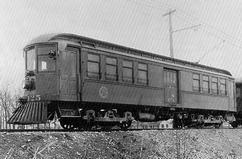
Interurban electric rail cars.
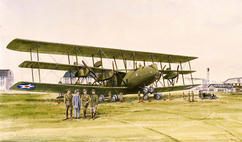
"Wilbur Wright Field 1923" by John McCoy. The huge airplane is the
Barlington Bomber, a one-of-a-kind experimental aircraft that was
tested here.
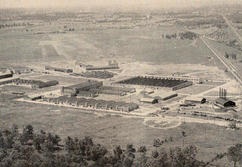
Wright Field in 1930.

Huffman Prairie Flying Field in 2013 still looks much like it did in 1904.
Botanists, however, will tell you the Prairie now hosts many
invasive species of flora that have crowded out the original prairie
sedge.
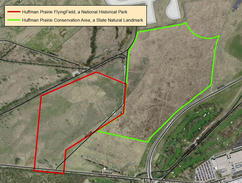
The Huffman Prairie Flying Field and State Natural Landmark rest
side by side in Wright-Patterson Air Force Base, Area C. There are
no plans to restore the Flying Field botanically as is being done in
the Natural Landmark, but one can hope. If you would like to watch
an excellent slide show that shows the flora and fauna at the
restored State Natural Landmark,
click HERE.
|
Newspaper
Coverage
After the first flights on December 17, 1903, Wilbur and Orville's brother
Lorin carried the news to an Associated Press representative Frank Tunison.
Frank also worked as a reporter at the Dayton Journal. Tunison
didn't think the four short flights were newsworthy and declined to run
the story – ironic since Orville and Wilbur had specifically asked the
telegraph operator in Kitty Hawk not to tell the local press; they wanted
to story to come out of Dayton so that their home town would get the
glory. The telegraph operator blabbed anyway, and an inaccurate story
appeared in the Virginia Pilot. This was repeated in the Cincinnati
Enquirer and the New York American on December 18. Later
that same day, the Dayton Daily News ran the first accurate account
of the flight.
|
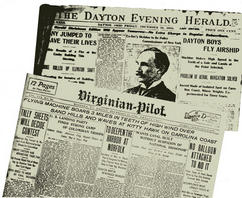
Two newspapers that ran a wildly inaccurate account of the first flight.
|
Names
and Nicknames
None of the Wright children had middle names. Instead, their father
tried to give them distinctive first names. Wilbur was named for Wilbur
Fiske and Orville for for Orville Dewey, both clergyman that Milton
Wright admired. They were "Will" and "Orv" to their friends, and their
neighbors knew them collectively as the "Bishop's kids." Within the Wright family, Wilbur was often referred to a "Ullam" and
Orville was "Bubs" or "Bubbo." Ullam was the German form of
"William." Wilbur's mother Susan was the daughter of German immigrants;
either she or his maternal grandparents may have given Wilbur his
nickname. "Bubbo" was as close as the 4-year-old Wilbur could come to
pronouncing the word "brother" when Orville was born in 1871. Their sister Katharine went by the nickname
"Swes," an affectionate German
diminutive for swesterchens, meaning "little sister."
|
|
Pets
The Wright family had at least three pets that we know about. When Wilbur
and Orville were children, they had a cat named "Old Mom." When
Wilbur was in France in 1908, he adopted a stray dog he called
"Flyer." Flyer traveled through France with Wilbur and was later
adopted by Hart O. Berg (the Wrights' agent in Europe) and his wife
Edith. Author/historian Suzanne Tate has written a children's book about
this lucky stray entitled
Flyer: A Tale of the Wright Dog. Later in life, Orville
bought a St. Bernard pup from Nina Dodd’s White Star
Kennels in Long Branch, New Jersey for $75 and had him shipped to
Dayton. Orville's sister Katharine named him "Scipio" after the famous
Roman general that had defeated Hannibal and thwarted an invasion of
Rome. The dog was much loved. When Orville died 15 years after Scipio
had passed, there were still photos of the St. Bernard in his wallet.
|

"Flyer" was a stray that turned up at Wilbur's hangar in France as
he was assembling his airplane.
|
Travel
Plans
In traveling to Kitty Hawk, the Wright brothers took the Big
Four train from Dayton to Cincinnati, where they caught a C &O train
to Old Point Comfort, VA. From there they took a steamer to Norfolk; a
Norfolk and Southern train to Elizabeth City, NC; and a sailboat to Kitty
Hawk or Manteo, NC. The C&O traveled straight through West Virginia,
including passage through the Big Bend tunnel of John Henry fame.
|
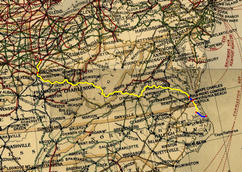
This 1898 railroad map shows the Wrights' path from Dayton to Kitty
Hawk. Yellow indicates travel by rail; blue is by ship.
|
Vacation Home
In 1916, Orville took his sister and father on
their first family vacation ever. At the suggestion of Orville's friend
and former botany professor, William Werthener, the Wrights stayed at a cottage on Georgian
Bay in Lake Huron. Orville fell in love with the rough landscape. In
many ways, it was like Kitty Hawk, completely devoid of modern
conveniences and unwanted interruptions. Before they returned home,
Orville had purchased a 20-acre island with a few derelict buildings.
In 1918, Orville made extensive renovations to
the primitive buildings on Lambert, creating a main cottage he named the
Cliff House, a guest house, pump house, ice house, boathouse, a water
tower and a unique funicular railroad used to carry guests and supplies to
the top of the 60-foot (18-meter) cliff. Cliff House was secured by
steel cables to the stony landscape to help the structure withstand the autumn
storms where winds could exceed 100 miles (161 kilometers) per hour.
Even so, the cottage eventually had to be relocated to a more sheltered
area when the winds caused some shifting.
Orville and his sister Katharine spent two
months of every year on Lambert Island, enjoying the wildness.
Because there was so much to do on the island maintaining and
improving the buildings, they also brought along a succession
of helpers – young men hired to do the heavy work.. They
continued make this annual trip together until 1926, when Katharine married Henry Haskell
and Orville became estranged from her. Thereafter, Orville continued
to visit Lambert, often accompanied by one or more of his nephews
and nieces (and later grandnephews and grandnieces). He was also
visited by many friends while at Lambert. In 1941,
as the Second World War approached, the US government – because
Orville was an advisor to the US military – sent representatives to
Orville’s cottage to escort him back to the United States. His
health declined after the war and he never returned to
Lambert Island.
Guy Johnstone, who presently owns Orville's boat the
Kittyhawk, has written a book about the
Lambert Island getaway and Orville Wright's time at Georgian Bay
entitled "From Kitty Hawk to Kittyhawk." There is also a
display and a collection of Orville's Lambert Island photos at the
Huronia Museum
in Midland, Ontariio, Canada.
If you would like to visit Lambert Island in Google Earth,
click HERE.
|

A view of Lambert Island from the air.
|
|
|
|

